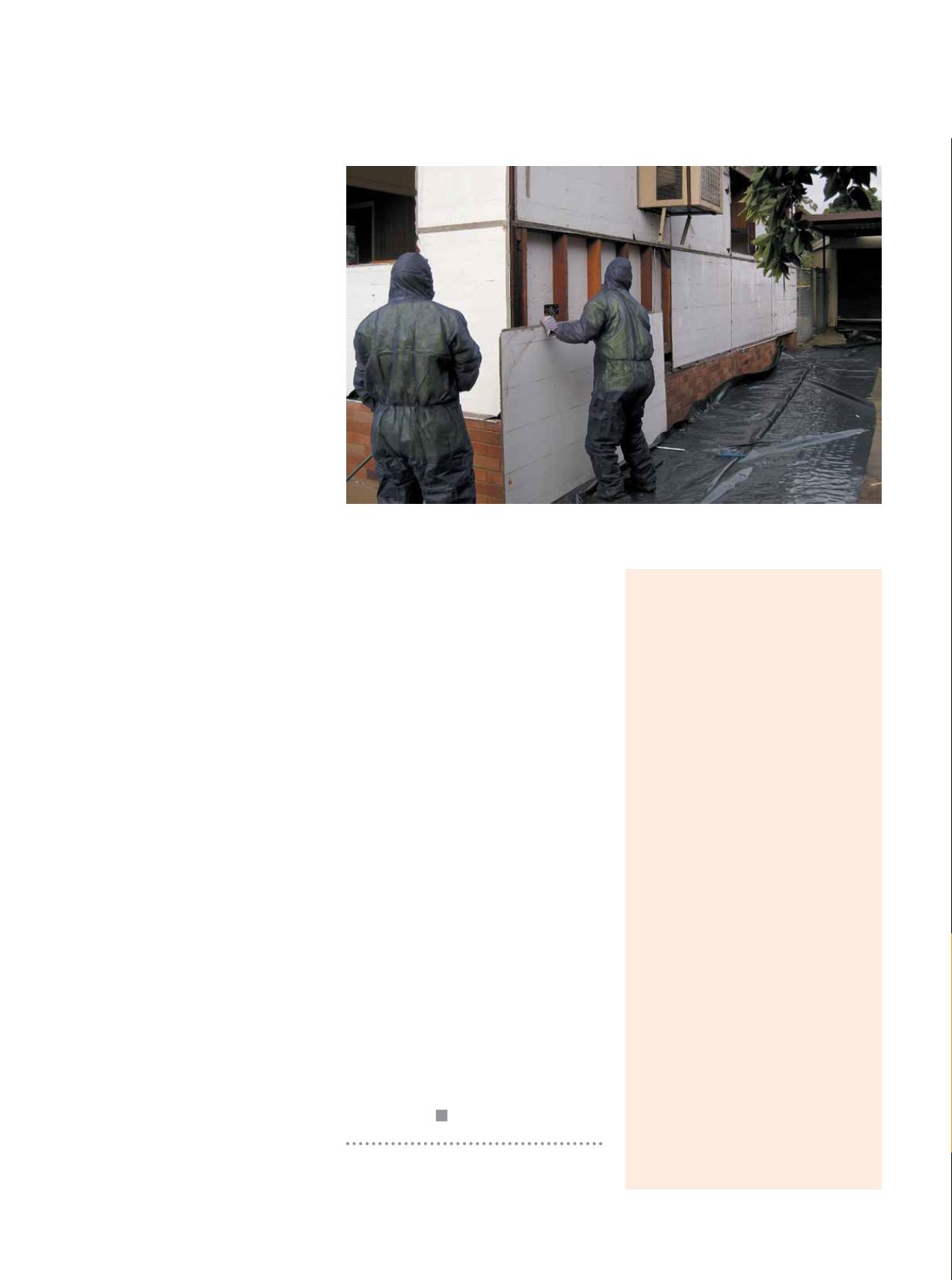

2 6
E L E CT R I C AL CONNE CT I ON
AUTUMN 2 01 5
holiday homes. In rural settings many
buildings were constructed from fibro as
a cost-effective means of housing farm
equipment and stock. It was also widely
used to construct ‘sleep-out’ additions to
farmhouses and workers accommodation.
ASBESTOS 101
Asbestos building materials are
described as either ‘friable’ or ‘non-friable’.
Friable asbestos is any material containing
asbestos and is in the form of a powder or
can be crumbled, pulverised or reduced to
powder by hand pressure when dry.
Friable asbestos was mainly used in
industrial applications.
Non-Friable asbestos is any material
(other than friable asbestos) that contains
asbestos. Non- friable asbestos cannot
be crumbled, pulverised or reduced to a
powder by hand pressure when dry.
Common uses for non-friable asbestos in
buildings include: flat (fibro), corrugated or
compressed asbestos cement sheets; water,
drainage and flue pipes; and floor tiles.
Products made from bonded asbestos
cement include electrical switchboards.
Dr Mike Lindsay, the acting director
of environmental health for WA Health
says most people mistakenly believe
asbestos is only found in roofs, fences or
walls in older style houses. But, products
containing asbestos can also include
paper backing material on sheet linoleum,
backing panels in meter boxes and vinyl
floor tiles.
“These types of products pose little risk
to health when they are in good condition
and undisturbed. But, people need to take
precautions when they are renovating
or doing maintenance work to prevent
asbestos fibres being released into the air,”
he says.
“Asbestos containing products can be
difficult to identify just by looking at them.
So, if in any doubt, treat it like it is asbestos
— just to be on the safe side.”
WA Health’s recommends:
>
If doing maintenance, or renovating
a house built before 1990, be aware it
could have asbestos containing products
and treat them with caution.
>
If buying a house, ask that asbestos
containing products be assessed as part
of the building inspection report.
>
Don’t use power tools to drill, cut, sand
or remove materials containing asbestos,
as this will release asbestos fibres.
>
Never use a high pressure cleaner to clean
asbestos cement roofing or cladding.
>
If removing small amounts of asbestos
containing products yourself, learn how to
safely remove and dispose of them first.
>
If in doubt, hire a licensed asbestos
removalist and check that the work area
is free from visible asbestos at the end of
the job.
So, when it comes to asbestos it’s
important to remember: don’t cut it, don’t
drill it, don’t drop it, don’t sand it, don’t
saw it, don’t scrape it, don’t scrub it, don’t
dismantle it, don’t tip it, don’t waterblast
it, don’t demolish it and, whatever you do,
don’t dump it.
> Asbestos Awareness
www.asbestosawareness.com.auUSEFUL WEBSITES
Thanks to the internet, you can now access
vital information about managing asbestos
safely.
National
>
Asbestos Safety and Eradication Agency
www.asbestossafety.gov.auAustralian Capital Territory
>
Asbestos ACT
www.asbestos.act.gov.au>
ACT Asbestos Taskforce
www.act.gov.au/asbestos-response-taskforce
New SouthWales
>
WorkCover
www.workcover.nsw.gov.au>
EPA
www.epa.nsw.gov.au/waste/asbestos/index.htm
Northern Territory
>
Asbestos Management
www.health.nt.gov.au/Environmental_Health/Asbestos_Management
Queensland
>
Asbestos Queensland
www.deir.qld.gov.au/asbestos/South Australia
>
Asbestos Occupational Health and Safety
www.safework.sa.gov.auTasmania
>
Asbestos Tasmania
www.asbestos.tas.gov.auVictoria
>
Asbestos Victoria
www.asbestos.vic.gov.auIf you’re in any doubt, treat it like it is asbestos — just to be on the safe side.
















